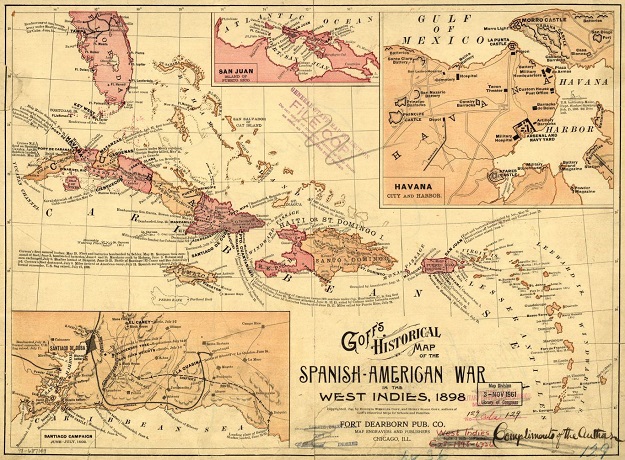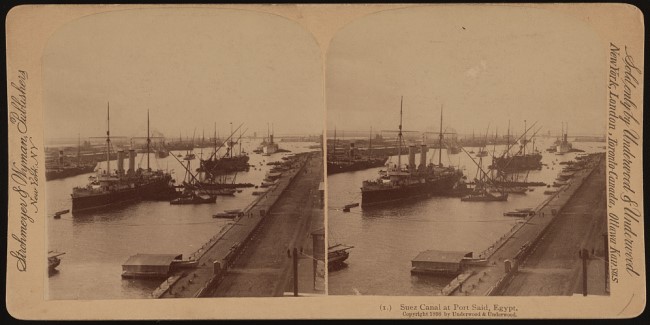

The following is summary of
the Spanish-American War - how and where it was fought. The war was a
worldwide conflict physically fought in Cuba,
Puerto Rico, Philippine
Islands and Guam. It was also politically
and diplomatically fought in Egypt. The war began with the blockade of Cuba in April, 1898. The war's fighting ended
with an armistice on August 12, 1898, and the war concluded with signing
of the Treaty of Paris on December 10,
1898
To read about the causes of
the war, please click here. For a chronology or
timeline of the war, click here.
The Summary:
The Spanish American War was
a worldwide conflict, being fought in the Atlantic and Pacific oceans, and
the Caribbean. It was fought in Spain, and her colonies – Cuba,
Puerto Rico, Philippine
Islands and Guam. It was fought in the
United States, and diplomatically in the Vatican and in Egypt.
Peripherally, it was fought in Hawaii, Germany
and Great Britain.
As the calls for war grew,
the Vatican, or more properly, the Catholic Bishop of Rome (the Pope)
worked diplomatically to avoid a war. Negotiations were held to find a way
for Spanish to meet the demands of the United States regarding Cuba.
However, though the effort looked promising, the negotiations could not be
completed before war was declared.
The War in the Pacific
The War in the Atlantic:

The War in Cuba:
Once Admiral
Cervera’s squadron was located in the harbor of Santiago, Cuba
on May 29 and a blockade established, the value of the squadron simply
became that of a squadron-in-being – a force that tied up U.S. Naval
resources but that could not logically survive an attempt to leave its
location. The Spanish squadron’a guns and trained men could serve to help
defend the city.
The major actions in Cuba
began with an attempt to cut the telegraph
cables and eliminate telegraph communications between Cuba
and Spain at Cienfuegos on May 11, 1898. The act of dragging the sea
bottom to locate and raise and cut the cables was done by men in small
sail and steam launches from the Cruisers MARBLEHEAD
and NASHVILLE while under direct enemy fire at close range. Two cables
were located and cut, but a third remained so the action did not fully cut
communications as it had hoped. Forty-nine of the men involved earned
Medals of Honor and three additional men were killed.
On June 2, an effort was
made to block the channel leading to the harbor by scuttling the collier MERRIMAC in the channel by a small volunteer
crew. The plan was to “bottle-up” Cervera’s squadron in the harbor,
eliminating the threat of a Spanish naval sortie. The MERRIMAC,
commanded by Naval Constructor Richmond Hobson,
was sunk, but it did not obstruct the channel as hoped. Hobson
and his crew were taken
prisoner.
The next major action was
the landing the of the First Marine
Battalion at Guantanamo Bay on June
10. The U.S. Marine force, consisting of both infantry and artillery,
landed and held an advanced beachhead. Then, at the Battle of Cuzco Well,
attacked a numerically superior Spanish force and drove them back twelve
miles. This eliminated land resistance in Guantanamo
and allowed the bay to be used for coaling and as a refuge for the force
blockading Santiago in case of hurricanes. It also defined the role of the
U.S. Marine Corps for the next century. The deaths of the Marines involved
were the first American deaths on the island of Cuba.
In June, the American army
forces began landing on the Cuban coast at Daiquiri and Siboney from a
thrown together flotilla of transports. Soon the troops began moving
inland toward Santiago. On June 24, a skirmish occurred at Las
Guasimas, a crossroad where the narrow paths leading from the beach
landing points of the Fifth Army Corps to Santiago. At the jungle
crossroads, Spanish forces made a stand against the leading forces of the
Major General William Shafter’s Fifth
Corps. The American forces involved included the 1st
U.S. Volunteer Cavalry (Roosevelt's “Rough
Riders”), and the 1st and 10th U.S. Cavalry regiments, and
supporting Cuban forces. The Spanish forces were pushed back, clearing the
route to Santiago.
On July 1, the forces
of Major General William Shafter’s Fifth
Corp began their assault on the ridges before the city of Santiago.
The assaults were against El Caney, Kettle Hill and San Juan Hill. El
Caney was expected to be taken in a short time, but the assault took
most of the day. The assaults on Kettle Hill and
San Juan Hill were also successful, and resulted in the American
forces holding the heights overlooking the city.
On July 3, under orders, Admiral Cervera’s Spanish squadron sortied from
Santiago harbor into the face of the larger blockading American squadron.
The Battle of Santiago resulted on the loss of
all four Spanish cruisers as well as two torpedo boat destroyers, with the
Americans losing no vessels.
On July 16, the Spanish
troops defending Santiago and the surrounding area surrendered to Major
General William Shafter. With this action, the fighting in Cuba
basically ended.
The War in Puerto Rico:
The invasion of the island
began on July 25, with the Americans fighting a series of skirmishes to
gain control of a number of ports on the island’s southern coast. The
initial landings were at Guanica. Soon the
American forces had control of Ponce, Arroyo
and Guayama.
Next, the action began with
a four-pronged campaign from the
territory now held in the south of the island. The plan was to drive the
Spanish towards the island’s capital of San Juan attempting to gain
control of as much of the island as possible. Actions occurred at Coamo,
the Heights of Silva, Heights of Guanamí, and also at Fajardo.
By the time of that the
armistice was reached ending the fighting, American forces controlled
about half of the island.

Stereocard
of
the Suez Canal in 1898 (Courtesy of the U.S. Library of Congress)
War in Egypt
The war in Egypt is the least known aspect of
the war, mainly because it was a war of military intelligence and covert
action, without any weapons being fired. The action, however, had a
profound impact on the progress of the war.
The Spanish had decided to
dispatch Admiral Manuel de la Cámara y Libermoore
with a powerful squadron – including the PELAYO,
CARLOS V, and supporting vessels to the
Philippines. The squadron departed Spain on June 16, with plans to proceed
to the Philippines via the Mediterranean, the
Suez Canal, and the Indian Ocean. However, having obtained news of the
movement, the United States began a series of covert actions designed to
slow the expedition and threaten the Spanish coast in an attempt to have
the squadron recalled.
First, on June 18, the U.S.
Navy formed the Eastern Squadron under Commodore John C. Watson,
with orders to threaten the Spanish coast. The squadron was not actually
formed in reality, mainly because it became unnecessary to do so. However
the orders for the formation of the fleet and its purpose were purposely
leaked to the Spanish government.
Additionally, working with
Great Britain, American operatives such was lieutenant William Sims worked
to slow Cámara’s Spanish squadron at the Suez Canal. First, under
neutrality laws, the British refused to allow the Spanish to coal their
ships in Egyptian waters. Separately, U.S. operatives had secured a lien
controlling all available coal supplies so that Spain was unable to
purchase needed coal. The Spanish squadron did eventually pass through the
Suez Canal on July 5-6, but was recalled to Spain on July 7. The reason
for the recall was the loss of Admiral Cervera’s
squadron at the Battle of Santiago and the
threat to the Spanish homeland represented by the unformed Eastern
Squadron.
Armistice and the End of the War
Casualties
Click here to learn about the casualties experienced by the United States and Spain.